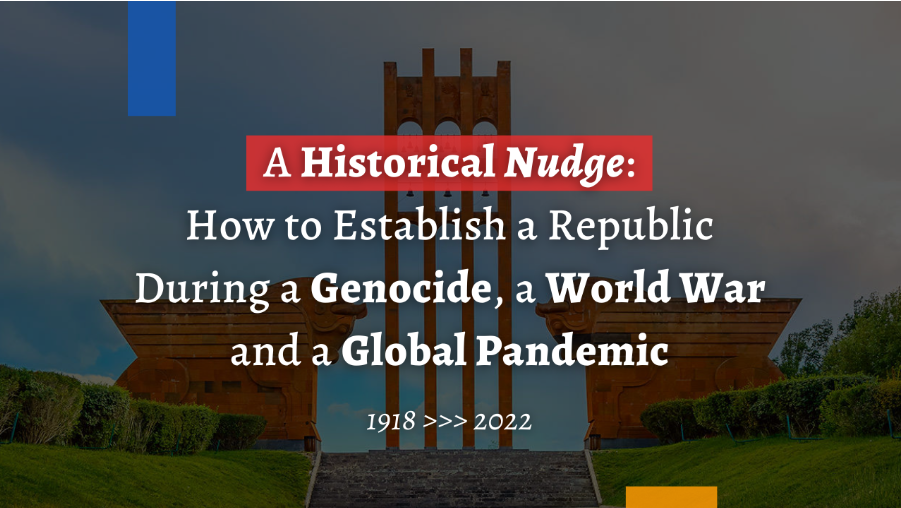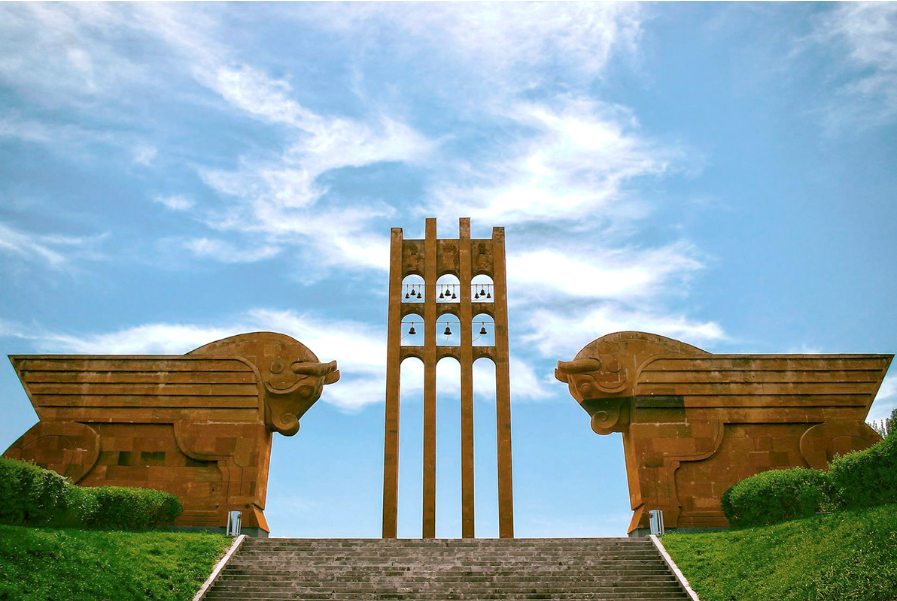By Hrant Boujikian - Armenia Media | Thursday, 09 June 2022

It’s November 9, 2020.
After reading the first lines that pop up on your social media feed you think to yourself:
“This is it. It’s all over. There’s no hope. Artsakh is gone... forever…”
To young Armenians growing in the Diaspora like myself, the aftermath of the 2020 Artsakh War brought an immense wave of negative feelings, emotions and thoughts associated with the way we viewed our connection with our homeland, its shattered political arena, as well as our motivation towards partaking in Armenia-linked activities. This was especially evident in the first couple of months following the supposed ‘end’ of the war.
With the supersonic speeds that negative news spreads through on platforms such as Twitter, Facebook and Instagram, it can sometimes be impossible to see a bright end to a seemingly dark tunnel that we pass through.
And as the dangers of further tragic cessations and humiliating acts are evident today,
the matter-of-fact is that the Armenian nation has gone through and overcome the worse,
and there is one particular chapter from thick Armenian history books that has stuck with me since childhood. It is nudging our elbows…
Sardarapat Monument, Armavir Province, Armenia
World War I is nearing its end. The Armenian Genocide, which began in 1915, is underway in Western Armenia (modern-day Eastern Turkey). The 1918 Influenza Pandemic (a.k.a. Spanish flu) is spreading rapidly worldwide.
You have world powers showing off their strengths, an influx of the remnants of a massacred people moving into Eastern Armenia, an enemy that is preparing to eliminate the Armenian population of Eastern Armenia, and a deteriorating global healthcare system with an influenza taking millions of lives.
«Երբ չի մնում ելք ու ճար, Խենթերն են գտնում հնար»
“When there is no hope in sight, the fools will find a way”
On May 28, the Republic of Armenia is born.
The Armenian Declaration of Independence comes to light.
After the heroic battles in Sardarapat (21-29 May), Bash-Abaran (23-29 May) and Karakilisa (25-28 May), Armenians were able to defend their homeland and crush the advancing Turkish army.
As the starting lyrics of the song ‘Sardarapat’ convey above, despite all challenges and complications, after independence was declared and the formation of the Republic of Armenia took flight.
To live freely, independently and peacefully on the homeland was a beating desire that the leaders of state had; to live with no external pressure and to be the ones to determine the destiny of the nation. Looking back in history, there are numerous elements and countless mini-stories that brought about the “how” of the 1918 Armenian independence and turned that into a reality.
In 1918, there was a sense of united spirit to end the struggle. From the most vulnerable, including surivovrs of the Genocide, to the working class and religious and intellctual leaders including Catholicos George V of Armenia and leaders of the Armenian National Council, which was the responsible body for and declaration of independence. Alongside providing a fair economic and social conditions to a wounded nation coming out of the ashes of a genocide during a world war with a global pandemic, nationalistic values were deeply entrenched in the leaders at the time with Aram Manukian being considered the founder of the Republic.
Since the fall of the last Armenian kingdom Cilicia in 1375 and the loss of Armenian statehood, 1918 was the first time Armenians could call themselves independent.
If Armenia did not declare itself independent in 1918, what we today call “Republic of Armenia” would not exist.
With the fall of the Soviet Union, the Supreme Council of the Armenian Soviet Socialist Republic redeclared independence, and the people of Armenia voted for an independent Republic of Armenia on September 21, 1991.
Since then, the months following November 2020 until today see the modern Republic of Armenia living its most challenging days ever. The current turmoil in the country with the opposition protesting the government is deeply rooted in…
At the very beginning of this writing, a reference was made to November 9, 2020. That’s when the leaders of Armenia, Azerbaijan and Russia signed a trilateral ‘ceasefire’ agreement which meant that 44-days of war supposedly ended, Armenian lands handed over to Turkey-backed Azerbaijan, and a tectonic shift to the future in the region.
To young generations and individuals who closely followed the developments of the war, this was a disastrous end; one that felt larger than any other loss in the books of history. The War took away not just 5000 lives and made a dent in a whole generation, it had serious geopolitical, economic and societal ramifications post-war. It was a catastrophic defeat, and very different to a victorious May 28.
Despite the contextual differences, there can be some links drawn between what our forefathers faced in 1918 and what we face as a nation today.
Today, the Armenian nation is still recovering from the remnants of the 2020 Artsakh War (think post-Genocide recovery), from the post-COVID-19-pandemic economic and health crisis (think 1918 global pandemic), all this within recent global security tensions following Russian invasion and launch of war in Ukraine (think WWI).
One clear difference, however, can be seen in the governing bodies of 1918 and 2022.
Despite some of the achievements of the Government led by Prime Minister Nikol Pashinyan, the country is at a weak position, unable to have a strong say in defence of the nation’s rights with prisoners of war still remaining in captivity, Azerbaijan’s continuous humiliation through border breaches and other acts as well as the Armenian Government’s pursuit of undignified peace with Turkey and Azerbaijan. This is a government that is losing the support of people day-by-day.
When all of this is happening, we think…
“This is a new Sardarapat”.
That’s how PM Pashinyan described the 2020 Artsakh War within the first week of the War. Although the statehood of Armenia was preserved and a fraction of the Republic of Artsakh remained, what followed the War were further attacks, intimidations, and human rights abuses. By no means, the end of it was truly a “new Sardarapat”.
Similar to 1918 when Turkish forces had aims at the remaining Armenian population in Eastern Armenia, today, we can see the same happen not only in Artsakh but Armenia as well, notably Syunik.
History seems to be nudging us that there actually is a need to defend our borders and national sovereignty. The story of First Independence seems to be reminding us of core leadership elements for the Armenian nation which seem to be neglected and abandoned today.
While writing these lines, the “Zartir Lao” movement in Armenia has been gaining momentum day after day - demonstrations, protests and online campaigns with the aim of resisting any further traitorous acts by the Government.
Although the movement has gained support of thousands of Armenians, it feels as though most are indifferent or have lost hope of positive moves that will benefit Armenia and Artsakh in the region. This is no blame on anyone. It is a description of the reality we face, and it seems as though the Pashinyan government will be in power for a while.
The Republics of Armenia and Artsakh are on the footsteps of further losses in pursuit of undignified peace with weak border security and untrustworthy neighbours. We do not have any right to turn our backs to those issues being faced today. It dishonours the memory of many who sacrificed their lives for the security and prosperity of our nation. Being educated on what is happening is the simplest thing we can do.
Looking into the months ahead, if the Armenian Government moves onto taking further risks with the worst-case scenario being the recognition of Artsakh as part of Azerbaijan, then the Armenian nation will be punished in the pages of history books.
The story of the establishment of the Republic of Armenia will remain one of the most heroic stories in Armenian history. As a growing nation, there is a strong potential that can be noticed with positive developments in Armenia and Artsakh in different fields such as technology and tourism. However, for all these to be achieved, peace is fundamental and essential; peace that is dignified and a lasting one. There is no such thing as “unconditional peace” in our modern world especially with genocidal neighbouring regimes.
The Armenian nation has gone through and overcome the worse, and so let’s not neglect the nudge, the reminder of the 1918 values that led to independence and the hope that resulted in the birth of the Republic of Armenia. They are inseparable when looking at the path of the Armenian nation moving forward.
comments
Կոչ Հայութեան ու Հայրենիքի Իշխանութեան
Editorial:1918-2024. The Struggle for Independent, Sovereign Statehood Continues
Armenia Media Updates: 29 March 2023 Edition
Armenia Media Updates: 23 March 2023 Edition
#TogetherForSyria Telethon Raises over $110,000 for Armenians In Syria
10 August 2022: Week to Week by Armenia Media with Shahen Araboghlian
3 July 2022: Week to Week by Armenia Media with Shahen Araboghlian
17 June 2022: Week to Week by Armenia Media with Shahen Araboghlian